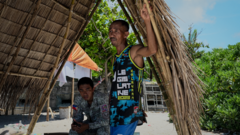Amidst the escalating tensions in the South China Sea, Pagasa Island, also known as Thitu, represents a steadfast spirit of resilience. This small island, controlled by the Philippines, is only 37 hectares in size and home to approximately 300 inhabitants living in a tight-knit community of modest wooden homes. The islanders rely on fishing in the clear turquoise waters and cultivating limited crops as their primary means of sustenance, but they face increasing challenges from a looming Chinese maritime presence.
Looming just offshore is a highly visible armada of Chinese vessels, including navy ships, coastguard patrols, and large fishing boats repurposed for China's maritime dominance. In recent years, China has been expanding its control over the South China Sea, asserting claims to nearly all of its waters and constructing military infrastructure on submerged reefs. In stark contrast, nations like the Philippines and Vietnam, much smaller in military might, strive to maintain their claims amidst this escalating territorial dispute.
What makes Pagasa unique is its civilian population, a rarity among the scattered islands of the South China Sea. According to Jonathan Malaya, an official with the Philippines National Security Council, Pagasa strengthens the country’s legal claims to the region due to its status as solid land with a resident community. Furthermore, its airport allows logistical support and reinforcement of its presence in these contested waters.
Reaching Pagasa remains a logistical challenge, involving a lengthy sea journey or a swift flight hindered by unpredictable weather conditions. Recent enhancements to its runway and infrastructure reflect the Philippine government's ongoing commitment to protecting its territorial claims. The community relies on regular supplies sent from the mainland, ranging from food to essential goods.
Historically annexed by the Philippines in 1978, Pagasa has evolving needs, supported by government aid for families living there. Yet, the fishing industry, previously viable, has become precarious due to aggressive Chinese patrols that intimidate local fishermen like Larry Hugo, who finds himself increasingly constrained to shallow waters closer to the island.
Even the educational facilities have grown, showing resilience through the years with a school now serving over 100 children. Residents, however, grapple with limited medical resources, often requiring evacuations for serious illnesses when inclement weather threatens logistics.
Pagasa embodies both charm and the unequivocal need to stand firm against external pressures. Amid the serene lifestyles of its residents, they present a united front, frequently encountering warnings from Chinese forces who assert that they are infringing upon Chinese territory. In contrast, the Philippine government maintains a diplomatic stance, formally protesting this interference as an assertion of sovereignty.
Despite historical challenges under previous administrations, the current government of the Philippines seeks to assert its position in negotiations with China without backing down, illustrating the complex dynamics in this volatile region. The spirit of Pagasa Island stands as a striking testament to hope, resilience, and the ongoing struggle for rightful claims over its waters.



















